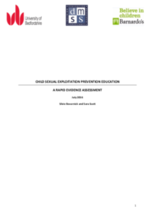INTRODUCTION
With their ability to reach the largest number of children and young people, schools have the potential to play an invaluable role in preventative education (Beckett et al 2013; The Education and Training Inspectorate 2014). However, while UK safeguarding policies recognise the unique position of schools and other educational settings in delivering prevention programmes to a ‘captive audience’ (OFSTED 2012; The Education and Training Inspectorate 2014), relatively little is known about what makes such work effective (Topping and Barron 2009). This briefing is based on a rapid assessment of the available evidence relevant to CSE prevention education. It brings together key messages from research and evaluation about what works to prevent sexual exploitation and promote healthy relationships. As specific evidence is limited, it also incorporates some messages from other kinds of prevention work in educational settings. It explores what successful interventions might look like, how they should be delivered, and what impact such interventions might be expected to achieve.

